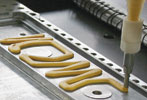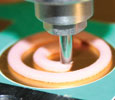
Dispensing cure-in-place gap fillers is expected to become the dominant technique for positioning thermal materials in electronic assemblies, as sectors such as automotive electronics, telecom equipment and low-energy lighting demand higher production throughput, thinner bondlines and reduced mechanical pressure on components and solder joints.
This trend will drive changes in the characteristics and handling of thermal materials, as well as in the assembly processes and equipment used on the factory floor.
Cure-in-place gap fillers
Thermally efficient pads and fillers have become vital in meeting demands to increase the performance and reduce the size of electronic assemblies, such as power supplies and control units, without compromising reliability. Today’s thermal materials are typically ceramic-filled silicone elastomers, which are easy to handle, conform well to the shape and surface texture of heatsinks or electronic components, and have high thermal conductivity relative to the still air they are designed to eliminate.
In addition, silicone-free thermal gap fillers have been developed for applications that are extremely sensitive to the presence of silicones. These are used primarily where there is a risk of electrical arcing or flashover, which is capable of converting silicones into insulating silica and thereby preventing correct operation of the system.
Pre-formed gap pads in standard or custom shapes, sizes and thickness, have at least one major attraction: they are extremely easy to use compared to older material types such as thermal greases. Greases are understood to be difficult to use and imprecise, and hence are not desirable in the modern production environment. However, a growing need is emerging for thermal materials that can be formed in place (Figure 1).

Cure-in-place thermal materials, deposited as a liquid, are able to achieve an extremely thin bondline, which enhances thermal conductivity and is preferred in highly miniaturised assemblies such as automotive ECUs. Careful calculation of the deposit shape and volume can minimise the pressure exerted on sensitive components such as small SMD passives and BGA chips when the unit is fully assembled; manufacturers of BGA devices often specify a maximum pressure per pin, which can be exceeded when the enclosure lid is tightened against a thermal pad placed on the component.
Additionally a cure-in-place material, when deposited, can be relied on to ‘wet out’ and hence conform extremely well even to rough surfaces. This enhances elimination of tiny air pockets, thereby improving thermal performance. The optimum volume and shape of the deposit can be assessed accurately by experimenting with glass test components, which provide a clear view of surface coverage and bondline thickness.
In practice, the characteristics of cure-in-place gap fillers can translate into better thermal performance than can be seen simply by comparing conventional parameters quoted in material data sheets. Even if a cure-in-place material has a lower apparent thermal conductivity (W/m-K) compared to mature types of thermal materials such as pads, the thinner bondline and excellent wetting properties of the cure-in-place material can deliver improved thermal properties in practice.
As a further advantage of cure-in-place materials, any design changes that alter the position or types of components used can be accommodated quickly by changing the shape and volume of thermal material deposited. If automatic dispensing equipment is used, this can be reprogrammed, thereby avoiding any need to re-order gap filler pads in different sizes or shapes (Figure 2).

Bergquist has successfully developed multiple types of non-corrosive, temperature stable, thermally conductive dispensable gap filler solutions. Among these are two-part materials that are designed to be mixed together when dispensed and to wet out to the adjacent surfaces, filling even the smallest air gaps and voids. Curing begins as the two parts are mixed and is completed after the material is in place. Once fully cured, the material remains a flexible and soft elastomer, which assists in relieving stresses due to coefficient of thermal expansion (CTE) mismatch during thermal cycling.
Material characteristics
Berquist’s dispensable gap fillers are thixotropic to varying degrees, and hence will retain shape after dispensing. An outside force must be applied to wet-out the material to the adjacent surfaces. These materials have a relatively high at-rest viscosity. However, when a shear force is applied, such as during the dispensing process, the viscosity decreases, allowing for ease of dispensing. In fact, the apparent viscosity is dependent on the shear rate; users should bear this in mind when testing and comparing materials. After dispensing, the material will regain its viscosity and so is able to remain in place on the assembly, holding its shape without running or dripping.
The behaviour of the material after dispensing and before curing is described in terms of its slump resistance. This index provides a measure of its internal cohesive characteristics (material consistency) combined with its adhesive characteristics (ability to adhere to the target surface). Bergquist gap filler offerings include a range of rheological characteristics and can be tailored to meet customer specific flow requirements from self-levelling to highly thixotropic materials that maintain their form as dispensed.
Two-part gap filler systems begin curing once the two components are mixed together. The pot life, or working life, is defined as the time for the viscosity to double after this mixing. Pot life is heavily dependent on temperature; it will decrease at temperatures above 25°C and increase at temperatures below 25°C.
The cure time of a two-part material is defined as the time to reach 90% cure after mixing. Two-part gap fillers will cure at room temperature (25°C), or cure time can be accelerated with exposure to elevated temperatures. Bergquist materials are available in several variations of pot life and cure time; these parameters are quoted in individual product data sheets. The shelf life under specified storage conditions is also quoted.
Although gap fillers are not designed as structural adhesives, they have an appreciable natural tack when cured that permits mild adhesion to adjacent components. This helps retain the material and eliminates pump-out throughout repeated temperature cycling. Factors affecting adhesion include surface cleanliness, geometry and texture. Hence recommended best practice when using gap fillers is to clean and degrease all surfaces thoroughly, using a solvent, and to allow the surfaces to dry completely before depositing gap filler.
Usage recommendations
Silicone based gap fillers typically are able to withstand continuous use at temperatures from -60°C to 200°C, for extended periods of time. In specific applications, however, it can be wise to study the performance and behaviour of the materials at both the low and high end of the temperature spectrum to ensure suitability for the conditions.
Two-part materials must be mixed to a 1-to-1 ratio by volume. As an aid to mixing, without requiring complicated measuring equipment, Bergquist provides disposable plastic static mixing nozzles. These can be attached to the ends of cartridges or mounted on automated dispensing equipment, and automatically mix the two parts together at the desired ratio.
Bergquist recommends purging newly tapped containers through the static mixer until a uniform colour is achieved. This will assure a proper 1-to-1 mix ratio. Unless otherwise indicated, mixing nozzles with a minimum of 21 mixing elements are recommended to achieve proper mixing. In order to ensure consistent material characteristics and performance, Bergquist two-part systems are always to be used with matching lot numbers for both parts.
For best results, dispense
Applicator guns and static mixing equipment provide an inexpensive means of dispensing for sampling and low-volume production. Bergquist offers manual hand triggered guns for its 50 cc, 200 cc and 400 cc cartridge sizes, as well as pneumatically operated guns for 200 cc and 400 cc cartridge sizes. Figure 3 illustrates examples of two-part container sizes currently available. Screening and stencilling are also viable for some materials, although users must consider the fact that material will begin to cure while on the screen or stencil.

Automated dispensing is by far the most suitable approach for high-speed in-line manufacturing; it permits greater repeatability as well as higher throughput. Bergquist supplies gap filler materials in high-volume container kits of up to 37,8 litre capacity, which are designed to ensure quick and easy loading and unloading.
Bergquist has alliances with several experienced vendors of automated dispensing equipment to further assist customers in creating an optimised dispensing process. This type of cooperation can help to optimise equipment design and performance.
Close partnerships with equipment suppliers also help to minimise equipment lead times, so that customers are able to move forward quickly as soon as the dispensing equipment requirements are finalised. This can provide an important enabler for fast-moving sectors, such as consumer and automotive electronics, to adopt cure-in-place gap fillers as a higher performing alternative to conventional thermal materials.
For more information contact Nico Bruijnis, The Bergquist Company, +31 35 538 06 84, [email protected], www.bergquistcompany.com

© Technews Publishing (Pty) Ltd | All Rights Reserved